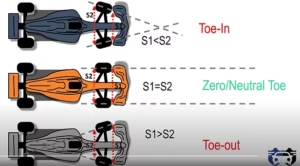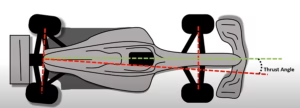
What is Toe Angle? How Does Toe Affect the Handling characteristics of Vehicle?
Toe refers to the difference in distance between the leading and trailing edges of the wheels when viewed from the top of the vehicle. The leading edge is where the front edge of the tire touches the ground, while the trailing edge is the rear edge.

Toe Conditions:
a. Neutral Toe (0): When the distance at the leading edge (s1) is equal to the distance at the trailing edge (s2), the tires are parallel.
b. Toe-In Condition: If the distance at the leading edge (s1) is less than the distance at the trailing edge (s2), the tires are converging or pointing inwards.
c. Toe-Out Condition: If the distance at the leading edge (s1) is greater than the distance at the trailing edge (s2), the tires are diverging or pointing outwards.
Impact on Vehicle Handling:

The distance at the contact patch between the centerline of the tire and the kingpin axis is known as the scrub radius. The scrub radius can be positive, negative, or zero.
Rear Wheel Drive Vehicles: As the car accelerates, the rear wheel drive pushes the front of the car forward. This causes a tendency for the tires to toe out while accelerating.
Front Wheel Drive Vehicles: As the car accelerates, the front wheel drive pulls the front of the car forward. This leads to a tendency for the tires and suspension geometry to toe in while accelerating.
Scrub Radius and Rolling Resistance: The rolling resistance acting at the center produces a torque about the steering axis due to the scrub radius. This torque can make the wheels toe out or toe in.
Handling Characteristics on Track:
Zero toe is best for straight line stability, while toe out allows the vehicle to follow tighter curves. Toe out condition makes the inner tire turn at a greater angle compared to the outer tire.
What is Thrust Angle?

The thrust angle refers to an imaginary line drawn perpendicular to the center line of the rear axle. It serves to compare the alignment of the rear axle with the vehicle’s center line and ensures that the rear axle runs parallel to the front axis.
If the wheelbase on both sides of the vehicle is the same, it indicates that the center line of the rear axle is parallel to the center line of the front axle. Drawing an imaginary line from the center of the rear axle will intersect the center of the front axis, resulting in a thrust angle of zero. However, if the rear wheels are aligned in such a way that the center line of the rear axle is not parallel to the front axis, the imaginary line drawn from the rear axle’s center will form an angle with the vehicle’s underline. This angle is known as the thrust angle and has an impact on the vehicle’s handling characteristics, often leading to increased tire wear. This misalignment is typically observed in independent suspension geometry and occurs due to improper toe settings.
When one wheel has too much toe while the other has too little, it is necessary to individually adjust the suspension on each side of the vehicle to achieve the proper toe setting. This ensures optimal handling and performance.
What is Dual Axis Steering System and How does it work?

Mercedes has introduced a new feature called the Dual Access Steering System, which provides drivers with an additional level of control over their steering. This innovative system allows the driver to adjust the angles of the tires while driving on the track. By pulling the steering wheel towards them, the driver can make the tires turn inwards, and by pushing it inwards, the tires will turn outwards. This adjustment helps in maintaining a zero toe alignment while driving straight.
To optimize the vehicle’s speed on straight lines and during cornering, Mercedes has implemented a mechanism that allows for the adjustment of the tire angles. The exact workings of this mechanism are not yet disclosed by Mercedes, but through online research and iterative analysis, it is believed that there are two possible ways to change the toe angles. One method involves moving the rack forward and backward on rail-like mechanisms, while the other method adjusts the length of the rack.
In this discussion, we will explore how the length of the rack can be adjusted to change the toe angles. This adjustment mechanism is referred to as the “split rack and pinion mechanism.” It comprises two racks for each wheel, two pinions for each rack, and these pinions are internally connected to the steering column helically. The helical connection between the steering column and pinion enables the pinion to rotate when the driver pushes or pulls the steering column.
As the driver pulls the steering wheel towards them, the length of the rack increases due to the pinions rotating in opposite directions. This results in a toe-in condition of the tires. Conversely, if the driver pushes the steering wheel, the length of the rack decreases, causing a toe-out condition. Once the desired toe conditions are achieved, the steering wheel can be rotated like a regular rack and pinion mechanism, allowing for both left and right turns. Overall, this mechanism is simple yet stable and provides an effective way to adjust the toe angles of the tires while driving.